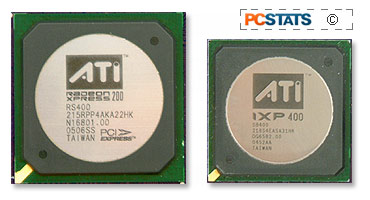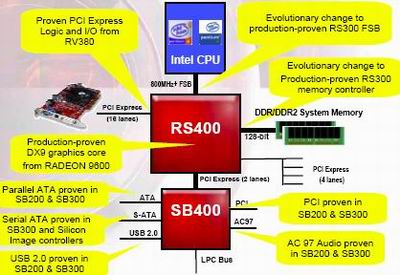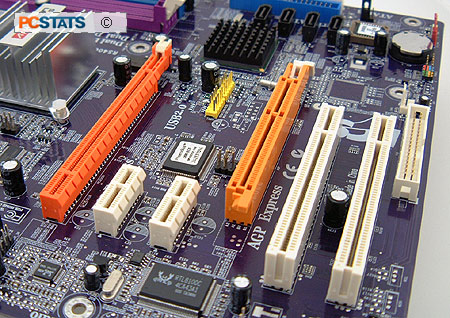 According to ATi the Radeon
Xpress 200 supports both Socket 478 and Socket
775 Pentium 4/Celeron 400, 533, 800, 1066MHz processors, so at first glance it looks
like ATi has built a very flexible chipset here. According to ECS though, the RS400-A motherboard
is only capable of supporting 533/800 MHz processors (and obviously not 400MHz FSB as this
is a LGA775 board).
According to ATi the Radeon
Xpress 200 supports both Socket 478 and Socket
775 Pentium 4/Celeron 400, 533, 800, 1066MHz processors, so at first glance it looks
like ATi has built a very flexible chipset here. According to ECS though, the RS400-A motherboard
is only capable of supporting 533/800 MHz processors (and obviously not 400MHz FSB as this
is a LGA775 board).
The
Radeon Xpress 200
chipset supports both DDR (DDR400) and DDR2 (DDR2-533) memory, but not at the same time.
The chipset itself can handle a maximum of 4GB (1GB DIMMs max) of non-ECC unbuffered memory,
be it DDR or DDR2. Since the ECS RS400-A has two DDR2 and two
DDR DIMM slots, you can only install a maximum of 2GB of system memory.
The
Radeon Xpress
200 is a PCI Express
platform which supports up to 20 PCI Express lanes; 16 of which are reserved for
the PCI Express x16 slot while the other four can be used with miscellaneous devices. According
to the preliminary RS400 documentation that PCSTATS received (not from ATi), integrated
into the RS400 Northbridge is a Radeon 9600 based videocard which will use
up to 256MB of system memory. This is easily ATi's strongest suit, as
the onboard Radeon 9600 class videocard should be better and more powerful than
any other integrated video solution on the market. Of course since it's an
integrated solution, you can't compare it to a standalone videocard. For the casual gamer, it
should be good enough.

Considering how new the IXP 400 'SB400' Southbridge is, its hardware specs seem a bit outdated. The
SB400 only supports Serial ATA (not SATA II), and just eight USB 2.0 ports. Audio comes care
of the inexpensive AC'97 codec. One has to really where the real features
are? Where is the RAID, Gigabit networking, or even a HD (High Definition) audio codec? These are pretty
much standard integrated features in most modern Intel-based motherboards.
|
What the heck is AC'97?
AC'97 was developed by Intel and stands for Audio Codec '97
(1997) but has been adopted by pretty much every chipset manufacturer.
AC'97 refers to two components the AC'97 digital controller which is built
into Southbridge chipset's and the AC'97 analog codec elsewhere on the
PCB. AC'97 audio supports 96 kHz
playback in 20 bit resolution and 48 kHz in 20 bit stereo multichannel
recording and playback. Compared to actual sound cards the playback
frequency and resolution is considered low with the average hardware
sound card supporting 192/24. Audio quality is probably the biggest
complain from AC'97 users.
Intel has recently released its
new High Definition Azalia audio codec which is to replace the AC'97
standard. The new Azalia codec addresses many issues with the older
standard such as low sampling rates and adds DVD class audio (Dolby
Digital, Digital EX, etc) to the equation. While Azalia costs more than
AC'97, we do expect more motherboard manufacturers to adopt the higher
quality Azalia in the near future. |
ATi has configured its RS400 chipset such that it connects to the SB400 via a PCI
Express x2 lane which is upgradeable to x4 if necessary. Unfortunately it is not
user
upgradeable. The connection is thus rated for 500MB/s bandwidth. Intel based
products all use much higher speed connections. I guess the Radeon Xpress 200's
saving grace is that it's inexpensive, and aimed at the entry level
market...
PCSTATS tried to dig a little deeper into the
Xpress 200 chipset, but ATi was not very forthcoming. What the company does provide on its
website is extremely vague. It makes us wonder if ATi is taking the motherboard
chipset industry very seriously, or perhaps is hiding something back from
the consumer that would provide its competition with a leg up? In any case,
requests to ATi for general information on the Radeon Xpress 200 went
unanswered.
AGP Express Anyone?
As you've
probably noticed, the ECS RS400-A motherboard comes with both a PCI Express x16 and 8x AGP express slot for videocards. As its name
hints, the AGP express slot actually runs through the PCI
Express bus! The RS400-A is not the first motherboard we've seen with both PCI Express
and AGP slot, but most others force the AGP videocard to turn through the extremely tight
PCI bus. In this case, it's possible for the AGP videocard to function almost
at normal speeds since PCI Express offers a lot more bandwidth than the
PCI bus can.

Unfortunately we experienced quite a few problems getting
an Asus Radeon X800 XT PE videocard to work, and instead had to switch over to a
MSI RX800XT-VTD256 videocard which has been validated for the platform by ECS.
